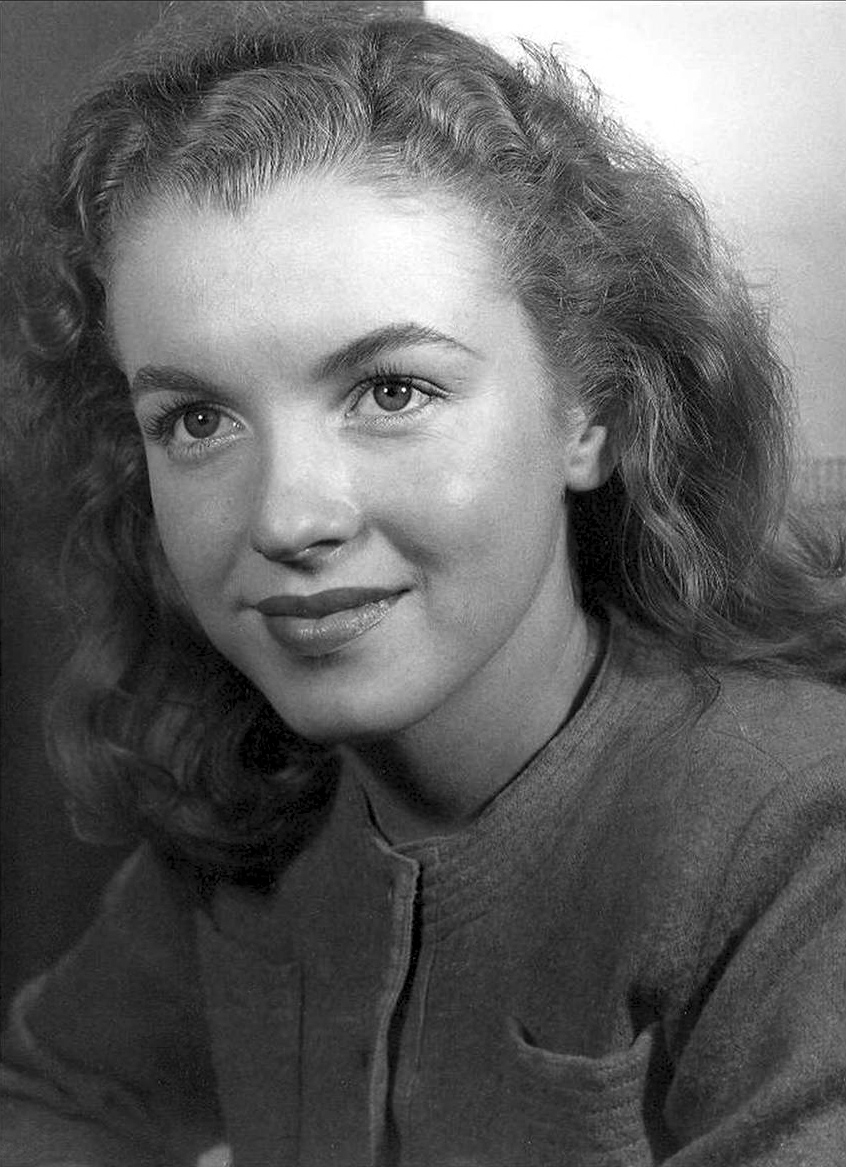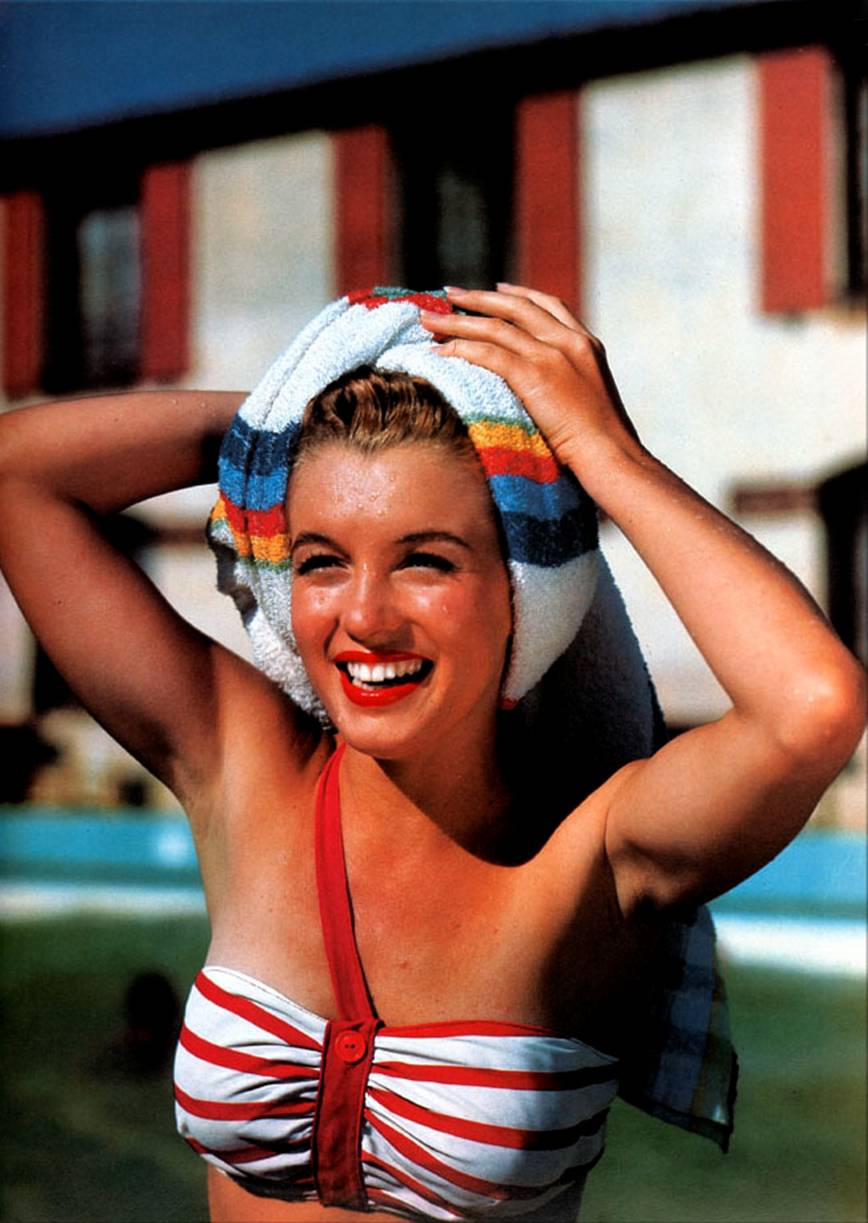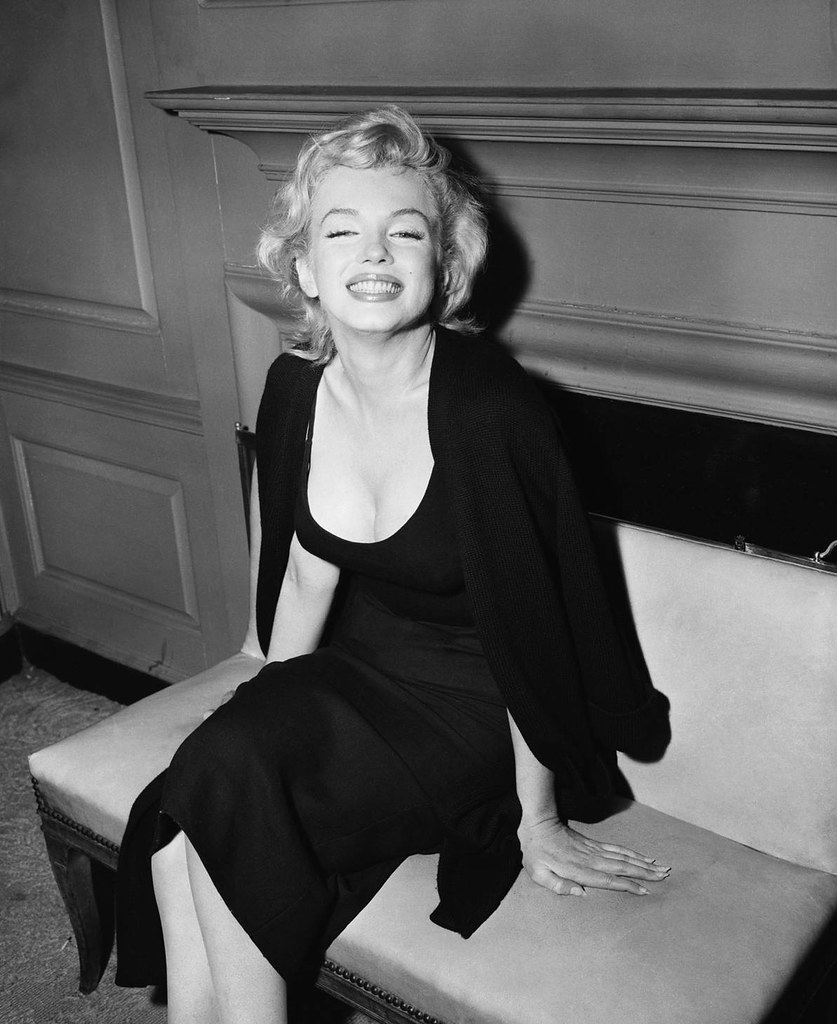
Marilyn Monroe and Joe DiMaggio at Tom DiMaggio's birthday party, 1954
Marilyn Monroe was talking on the telephone to Louise DiMaggio when she was murdered and was able to utter the name of her attacker before her death, according to a new book by DiMaggio's niece and Monroe confidante June DiMaggio.
In "Marilyn, Joe & Me," 44 years after the Hollywood superstar's mysterious death, which was ruled a suicide, June DiMaggio, friend of Marilyn and niece of New York Yankee Hall of Famer Joe DiMaggio, she discloses that her mother was speaking long distance with Marilyn Monroe when the actress was killed. DiMaggio says her mother overheard Monroe blurt out the name or names of her killer as they stormed into her bedroom.
Now in her late 70s, DiMaggio knew Marilyn before she was married to her uncle and for years afterward – until the star's death in 1962.
"It's about the truth, and it's about time," DiMaggio says, explaining why she is finally publishing her memoirs.
"Mother told me that she knew who killed Marilyn, but that knowledge absolutely terrified her," she writes.
A Thousand Photos of Marilyn Monroe
To protect her family, she said that she would never reveal the details of what she knew.
"I begged mother to tell me who it was, over and over and over again," says June.
Joe DiMaggio also pleaded with her to confide in him many times. Only her mother knew, and she never confided in Marilyn's former husband or anyone else.

"I even asked her on her deathbed," she recalls. "'Won't you tell me now?' And she just said, 'No, I want my family to live.'"
By DiMaggio's account, Marilyn was indeed the victim of a wretched childhood and the Hollywood studio system that made her star power last to this day.
Still, she paints a picture of a different Marilyn, one who faced life sunny-side-up, who seemed to accept her fate on many levels. She divulges a Marilyn who read books and loved to talk about politics, who was unwavering in her generosity, who had an almost naive sense of wonder. She portrays a Marilyn sometimes lonely, who wasn't even aware of her hundreds of Christmas cards that flooded the studio; a Marilyn that cooed over a stuffed Teddy bear and took childlike pleasure in watching cartoons. And yes, a Marilyn who also admitted to spending time on the casting couch.
DiMaggio writes, "On the very day of her death, Marilyn phoned me mid-morning and asked if I could bring her one of my homemade pizzas.
"When I arrived with the pizza around noon she was in high spirits, chatting about how she and my mother were going to Mexico to shop for wrought-iron patio furniture for the new home where she and Joe would live after they remarried.
"Yes, remarried. Authors June DiMaggio and Mary Jane Popp
"They were planning to retie the knot on August 8, the day that would instead be her funeral. Marilyn was very happy and excited to be marrying Joe again. She was even thinking of domestic comforts and bought a set of dishes for their new love nest.
"When I saw her that fateful day, she went on and on about her new life and her plans for the future. She had a contract to fulfill, but she was hoping to cut back to perhaps a movie a year so that she could finally begin to enjoy life with her own family, in her own cozy home.
"On the night that she was murdered," DiMaggio relates, "the police were trying to locate Joe to tell him that she'd been found dead. When they arrived at my door that night between 11 p.m. and midnight, I was in shock. I didn't know where Joe was for sure, so I called to ask Mother. I remember thinking that he might be in San Francisco. When she picked up the phone she was sobbing uncontrollably.
"She already knew.
So, who was Marilyn's killer?
DiMaggio, whose bright eyes belie her strength and feistiness, is stalwart in her belief. She says her mother never told her the name, because she was desperately afraid for her family. "Only Mother knew, and she never confided in Joe or anyone else. He kept asking her, 'Won't you tell me now, Lee?' And she just said, 'No, I want my family to live.'
"Even after the FBI traced that last call that Marilyn made to Mother, not even the country's G-men could make inroads with her. As she told me directly and in no uncertain terms, she wouldn't tell anything to the FBI or to another living soul."
But then there's an interview co-author Mary Jane Popp happened upon, which breathes life into DiMaggio's account. Popp interviewed Alan Kimble "Kim" Fahey, author of "Hollywood Unlisted," in which he tells hair-raising stories of the 35 years that he worked as a telephone repairman in the land of stars and stories, when he "kept his ears open and his mouth shut."
"The story took place around the early '80s, when Kim was sent to do about three days of phone work on a system at Atascadero State Mental Hospital, a maximum-security facility on California's central coast. Kim was minding his work, converting an old switchboard to a new phone system, when he was confronted by a thin, wiry man.
"The Guy, as I will refer to him, was in his late 50s or early 60s, of medium build, maybe 145 pounds, with slicked-back, graying hair. Kim said that he spoke in a streetwise tone and seemed desperate to talk to someone.
"He told Kim he was a small-timer in the Sam Giancana crime family in the East. The goal of anyone working for the mob was to move up in the family, so when he was told to go to California to do the deed he had no hesitation. He was told to shut Marilyn up and get a journal she had been keeping.
"It seems that what she was writing in that journal was making some very powerful people nervous. The Guy had never been to Los Angeles and didn't know his way around, so a driver was provided for him and his partner.
"They stalked Marilyn for several days to find out her routines. They discovered that part of her nightly routine was to sedate herself a little, take a drink or two, and crash on the bed in her bedroom with the TV on.
Marilyn Monroe takes a break on the set of "The Misfits.""During the time they stalked her, they also lifted her keys and had duplicates made of all of them, since they weren't sure which ones they would need. Finally they chose the night to make their move.
"They let themselves in the front door. The Guy said they didn't see anyone else in the house. They entered her room and, as expected, found Marilyn in bed.
"Before she could react, they were on top of her. Both men held her down while the Guy inserted a nembutol suppository (supplied for the purpose when they arrived in California) into her rectum. They had been told that it would work quickly and that it would not show up in an autopsy.
"The Guy said that Marilyn struggled for only a minute or so, and then she stopped breathing. All was quiet. The search for the journal didn't take long; they found it under the mattress. They left in a matter of minutes, making sure that the front door was locked behind them and leaving no evidence of a break-in.
"The Guy thought he was going to move up in the Giancana crime family because of his slick work, until he heard that his partner had been murdered and that there was a contract out for him, too.
"He told Kim that he stole an ID that had a physical description close to his. He didn't want to be arrested and put in the general population in prison, because he knew the mob could get to him from inside.
"So he got a crazy idea to pretend that he was crazy. He got into an altercation in a restaurant, acted nutty, got arrested, and was subsequently admitted to Atascadero State Mental Hospital.
"Crazy as the plan was, it might have worked. He may have thought that he could hide in the hospital and be released when things cooled off. What he didn't know was that the stolen ID was from a guy with a rap sheet longer than his arm who was a bona fide nut case."
In addition to revealing new and startling information surrounding Monroe's death, DiMaggio and Popp also tackle rumors and conspiracy theories about Frank Sinatra's involvement, the FBI, and potential ties to the Kennedy family.
Popp also recently did an exclusive interview with Gene Anthony, world-renowned photographer, who was only one of two photographers allowed to freely photograph Marilyn Monroe's funeral.
As Popp related, "I couldn't believe my ears when Gene told me how he had gotten a call at about 2 a.m. Pacific time from his New York agent who had already been called by a German magazine from Germany, telling Gene to get down to Hollywood to cover Marilyn Monroe's death. There have been stories claiming her body was not even discovered until 3:30 a.m. How then did Gene get this early morning call to cover the story? It all comes down to what June has told me all along. Marilyn was murdered before midnight when the police arrived at her door with the news."
Adding yet another timely twist, former Los Angeles County prosecutor John Miner, now 88, has recently spoken again about reopening the investigation into her death and exhuming her body to reexamine it and reconsider the finding that she committed suicide.
"What I do know after my investigative interviews and my long relationship with June is that Marilyn was murdered. I have no doubt," Popp concludes.
Read more: Stunning new revelations:<br> Marilyn Monroe murdered http://www.wnd.com/?pageId=38425#ixzz1GQwS8JGj
The final years of Monroe's life were marked by illness, personal problems, and a reputation for being unreliable and difficult to work with. The circumstances of her death, from an overdose of barbiturates, have been the subject of conjecture. Though officially classified as a "probable suicide," the possibility of an accidental overdose, as well as the possibility of homicide, have not been ruled out.
In 1999, Monroe was ranked as the sixth greatest female star of all time by the American Film Institute.
Marilyn Monroe (June 1, 1926 – August 5, 1962), born Norma Jeane Mortenson, but baptized Norma Jeane Baker, was an American actress, singer and model. After spending much of her childhood in foster homes, Monroe began a career as a model, which led to a film contract in 1946. Her early roles were minor, but her performances in The Asphalt Jungle and All About Eve (both 1950) were well received. She was praised for her comedic ability in such films as Gentlemen Prefer Blondes, How to Marry a Millionaire, Some Like It Hot and The Seven Year Itch, and became one of Hollywood's most popular and glamorous performers.
The typecasting of Monroe's "dumb blonde" persona limited her career prospects, so she broadened her range. She studied at the Actors Studio and formed Marilyn Monroe Productions. Her dramatic performance in William Inge's Bus Stop was hailed by critics, and she won a Golden Globe Award for her performance in Some Like it Hot.
Signed with Fox in 1946 for $125 per week.
Studied at UCLA
Was voted Miss California Artichoke Queen of 1947
Was a descendant of President James Monroe
Underwent psychoanalysis
Roomed with Shelley Winters during her early Hollywood days
Was a fan of Beethoven, Mozart, and Louis Armstrong
Was Truman Capote's original choice for the part of Holly Golightly in Breakfast at Tiffany'sRelated People
Related Sites
Watch Marilyn Monroe videos
>> Marilyn Monroe Photo Gallery
Actress. Born Norma Jeane Mortenson (later baptized as Norma Jeane Baker) on June 1, 1926, in Los Angeles, California. During her all-too-brief life, Marilyn Monroe overcame a difficult childhood to become of the world's biggest and most enduring sex symbols. She never knew her father, and her mother Gladys, developed psychiatric problems and was eventually placed in a mental institution. Growing up, Monroe spent much of her time in foster care and in an orphanage. In 1937, a family friend and her husband, Grace and Doc Goddard, took care of her for a few years. But when Doc's job was transferred in 1942 to the East Coast, the couple could not afford to bring Monroe with them.
Once again, Monroe faced life in foster care. But she had one way out—get married. She wed her boyfriend Jimmy Dougherty on June 19, 1942. A merchant marine, Dougherty was later sent to the South Pacific. Monroe went to work in a munitions factory in Burbank where she was discovered by a photographer. By the time Dougherty returned in 1946, Monroe had a successful career as a model. She dreamt of becoming an actress like Jean Harlow and Lana Turner.
Her marriage fizzled out as Monroe focused more on her career. The couple divorced in 1946—the same year she signed her first movie contract. With the movie contract came a new name and image, she began calling herself "Marilyn Monroe" and dyed her hair blonde. But her acting career didn't really take off until the 1950s. Her small part in John Huston's crime drama The Asphalt Jungle (1950) garnered her a lot of attention. That same year she impressed audiences and critics alike as Claudia Caswell in All About Eve, starring Bette Davis.
In 1953, Monroe made a star-making turn in Niagara, starring as a young married woman out to kill her husband with help from her lover. The emerging sex symbol was paired with another bombshell, Jane Russell, for the musical comedy Gentlemen Prefer Blondes (1953). The film was a hit and Monroe continued to find success in a string of light comedic fare, such as How to Marry a Millionaire with Betty Grable and Lauren Bacall, There's No Business like Show Business (1954) with Ethel Merman and Donald O'Connor, and The Seven Year Itch (1955). With her breathy voice and hourglass figure, Monroe became a much-admired international star.
Tired of bubbly, dumb blonde roles, Monroe moved to New York City to study acting with Lee Strasberg at the Actors' Studio. She returned to the screen in the dramatic comedy Bus Stop (1956), playing a saloon singer kidnapped by a rancher who has fallen in love with her. She received mostly praise for her performance.
In 1959, Monroe returned to familiar territory with the wildly popular comedy Some Like It Hot with Jack Lemmon and Tony Curtis. She played Sugar Kane Kowalczyk, a singer who hopes to marry a millionaire in this humorous film in which Lemmon and Curtis pretend to be women. They are on the run from the mob after witnessing the St. Valentine's Day Massacre and hide out with an all-girl orchestra featuring Monroe. Her work on the film earned her a Golden Globe Award for Best Actress in a Comedy.
http://www.flickr.com/photos/39766756@N07/sets/72157620462319726/show/with/4019602736/










No comments:
Post a Comment